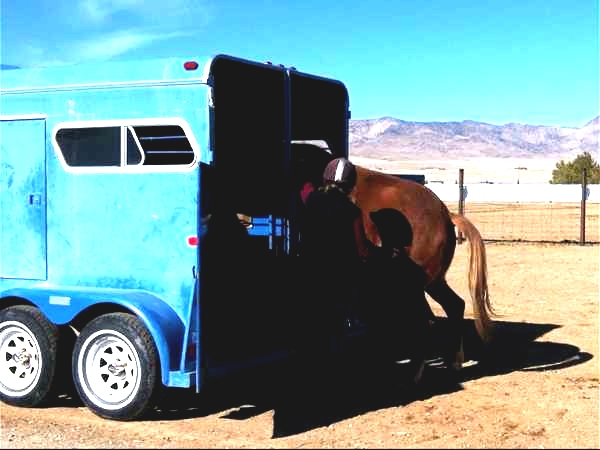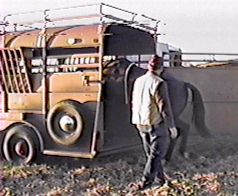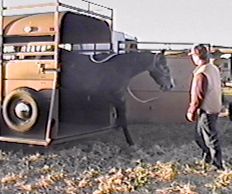- Lack of proper preparation. The horse handles poorly in general on the line yet the handler expects it to reliably enter a trailer when asked. Except in unforeseen circumstances, horses can be taught to be responsive on the lead line well in advance of trailer loading day and they should be.
- Nervous energy on the part of the handler, particularly if running late and trying to make up time. Nervous energy is contagious and a nervous horse is less likely to load smoothly.
- Lack of confidence on the part of the handler. If the handler is anxious about loading, that anxiety can easily be communicated to the horse.
- Lack of a plan. If the handler doesn't really know what he or she is doing, how is the horse supposed to know?
- Too much intensity on the part of the handler. Predators on the hunt are intense. Intensity can be disquieting to prey animals. It's a difficult concept for some people to direct energy without exceeding the intensity needed to produce the desired result.
- Lack of focus on the part of the handler. Safe and efficient loading involves quiet directed focus on the objective.
- Letting the horse's mind wander. When a horse is not loading efficiently, it can't be allowed to constantly gaze off in different directions that it would prefer to go. Time and again people complain about how poorly their horses load and we discover that they let their horses' attention drift all about, sometimes to the point that the horse's head has turned completely away from the trailer before they make the correction.
- Treating the horse like a dragon ("drag-on.") You can force a horse into a trailer, however a pulling contest typically produces opposition reflex in horse, head spiking (including the horse striking the trailer roof with its head) and occasionally the horse dragging the handler out the trailer (a "drag-out.") The handler needs to correct the horse's direction and maintain forward focus but not get into a pulling contest with a 900+ Lb. animal. The horse isn't a "dragon" and the handler isn't a "dragout."
- Incorrect body position on the part of the handler. Whether sending or leading a horse into a trailer, correct body position is crucial. The handler's message, as perceived by the horse, can't be a multiple choice presentation that the horse can choose from. When driving the horse, handlers often shut down the load by directing energy in front of the horse's drive line, thus setting up a choice (load up or back out.) The horse will choose the answer it prefers. The same goes when leading the horse in and the handler turns around and stares down the stalled horse, projecting a "don't crowd me" message. The horse often responds by backing out. The handler has to think about what message his or her body language is sending.
- Poor timing on the part of the handler (Part 1.) Some horses simply need to do a safety check before stepping into something uncomfortable. Since I ride a lot of difficult trail, I will never willingly discourage a horse to exercise safe behavior. So it frustrates me when I see a horse simply wanting a few seconds to scope out a situation while the handler is trying to drive it forward. A few horses will use a safety check as a stalling tactic, but with most horses, once they feel confident, will raise their heads to a normal position and "check in" with their handlers for directions. Ask the horse to load when it's ready to move forward.
- Poor timing on the part of the handler (Part 2.) Some horses will try to avoid focusing on the trailer, try to look around it, swing back and forth, etc., and their handlers will allow them to commit to this behavior before making a necessary correction. Thus the horse, and sometimes the handler, will be moving all over the place. Horses are actually pretty transparent. Correct that misdirected focus before it produces misdirected movement. With most horses, once they realize that the handler is "in tune," they go along with the program.
- Too many helpers. I can't recall how many times one or two of us have gone to a situation where a horse refused to load for hours and we walked into "energy chaos" with a gaggle of people arguing over how to get the horse in the trailer. We'd move everyone back at least 100 feet, I'd show a roll of duct tape and threaten anyone who generated a bunch of chatter with getting his or her mouth taped shut, and the horse would generally load in a matter of seconds. Oftentimes it is helpful when leading a horse into a trailer for the handler to suggest the direction of travel and someone outside carefully directing energy behind the horse. However both parties need to be reading the horse "real time" as well as each other. Once the humans are in synch, loading is generally a snap.
- Insisting on sticking with a bad plan. For some reason some handlers insist on continuously attempting an operation that isn't working. Sometimes we will repeat an operation, particularly when the horse improves with each attempt. However other times there is some factor that prevents success. When getting nowhere, stop and assess what element of a particular operation is failing and make a necessary correction.
- Treating loading as a job rather than as a training scenario. Any time we handle a horse the horse will learn something positive or negative. If we're loading horses out during a disaster, all bets are off. However if we are loading a horse under any other circumstance, we want the horse to learn to get more comfortable and efficient with the loading process. Thus the objective is to teach rather than force the horse during difficult loading operations.
- "Load and go" behavior. Getting a horse into a trailer and slamming the rear gate is not likely to build the horse's confidence and make future loading any safer. Whenever time permits, we will load difficult horses multiple times, generally until they will load on a light "ask" or hand cue.
- Failure to reward desirable responses. I'm not for gushing all over a horse for good behavior, but some kind of positive feedback is very desirable when a horse is working through a challenging or anxiety producing activity. Horses learn at the point of release of pressure, however they can be reassured and their confidence improved by reinforcing an excellent "try" with appropriate positive feedback.
|
 KBR Horse Net
KBR Horse Net


